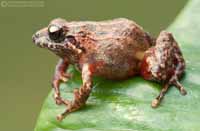New Frog Species Discovered in Sangay National Park, Ecuador
 The bamboo rain-peeper measures a mere 20-25mm and is recognized by orange marks where the front and hind limbs meet the body
The bamboo rain-peeper measures a mere 20-25mm and is recognized by orange marks where the front and hind limbs meet the body Cuenca, Ecuador (7 July 2011) – Fundación Cordillera Tropical reports the discovery of a new frog species, the bamboo rain-peeper (Pristimantis bambu), in Sangay National Park, Ecuador. Catholic University biology student, Alejandro Arteaga, discovered this thumb-sized frog within the privately managed Mazar Wildlife Reserve, in the Park’s southern region. The bamboo rain-peeper is the second new frog species identified on the reserve in recent years, and its discovery, undoubtedly, merits an increase in efforts to catalogue and protect this region’s unique biodiversity.
The bamboo rain-peeper is one of more than 400 frogs of the genus, or group, called Pristimantis, the largest frog genus in the world. Rain-peepers live in the tropical forests of Latin America and this species exclusively inhabits bamboo patches within high elevation montane forests. These frogs exhibit a novel reproductive method unique to their forest lifestyle. They do not have a tadpole stage but, rather, emerge as small ¨froglets¨ from eggs laid in the forest.
The 1,800 hectare Mazar Wildlife Reserve is the only place in the world that the bamboo rain-peeper is currently known to live. The Reserve’s well-conserved forests and páramos, ranging in altitude from 2,800 to 3,600 meters, host an exceptional diversity of amphibians for its elevation, including rain peeper, marsupial and poison dart frogs. In 2008, biologists Martin Bustamante and Dr. Joseph Mendelson of the Catholic University in Quito discovered and named the Mazar rain-peeper (Pristimantis gagliardoi), revered by researches as ¨spiky¨ for the small spikes on its head and back. Later, in 2009, Arteaga found three individuals of the critically endangered Andean poison dart frog (Hyloxalus anthracines), that was previously thought to be extinct, living in a small mountain stream at nearly 3,000 meters.
 Researchers search for frogs at night, when they are most active
Researchers search for frogs at night, when they are most active To formally name this species, Arteaga and colleague, Dr. Juan Guayasamin of the Indo-American Technical University, studied the species’ physical traits, songs, and habitat preferences. The variability between individuals required the use of diagnostic genetic testing to differentiate this species from similar ones. They published their results in the May 2011 issue of Zootaxa. ¨We believe that there may be at least two additional new species of Pristimantis living on the Reserve, suggesting that there is still work to be done,¨ reports Alejandro, in a response to a question about the future plans of this young biologist.
The discovery of the bamboo rain-peeper indicates private as well as public lands throughout southern Ecuador harbor vulnerable and endangered plants and animals, making them critical partners in biodiversity conservation.“The promise of future discoveries in the area is a tantalizing one for researchers to contemplate, and serves as an impetus for conservation groups to support the stewardship of private lands,” comments Catherine Schloegel, Executive Director of Fundación Cordillera Tropical.
